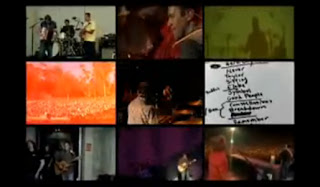The Drums artwork for their two albums, “The Drums” released on 7th June 2010, and “Portamento”, released on 2nd September 2011 are both mainly photographed image. The debut album, self titled, is of cut out letters of the band name stood alone on a dusty, wooden floored stage, lit from back left, producing a large shadow onto the shiny floor. In the background are velvet blue stage curtains; the overall effect that the debut album is a large, attention seeking stage performance.
The second album artwork is again a photograph, however containing two people. There is a young boy stood alongside his mother or grandmother perhaps, whose eyes have been edited through computer graphics; his eyes filled in a deep red to symbolise possession and the Devil. This connotation is also given through props in the background, a wooden Cross is hung directly above the boy’s head onto the wall. The picture is again of an 80s style, like in the “Best Friend” music video; it could possibly have been taken by a Polaroid or film camera, rather than digital image.
The album title appears to the top right of the cover, typed in large black, bold font inside a white box. The box also contains directly underneath, in smaller font, the band name and a track list. This isn’t very common in typical albums, as the cover usually focuses mainly on the image, rather than font.
The album title appears to the top right of the cover, typed in large black, bold font inside a white box. The box also contains directly underneath, in smaller font, the band name and a track list. This isn’t very common in typical albums, as the cover usually focuses mainly on the image, rather than font.












































